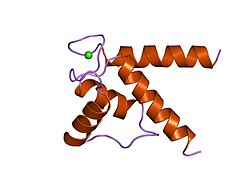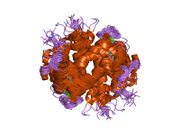Biology:S100B
 Generic protein structure example |
S100 calcium-binding protein B (S100B) is a protein of the S-100 protein family.
S100 proteins are localized in the cytoplasm and nucleus of a wide range of cells, and involved in the regulation of a number of cellular processes such as cell cycle progression and differentiation. S100 genes include at least 13 members which are located as a cluster on chromosome 1q21; however, this gene is located at 21q22.3.
Function
S100B is glial-specific and is expressed primarily by astrocytes, but not all astrocytes express S100B. It has been shown that S100B is only expressed by a subtype of mature astrocytes that ensheath blood vessels and by NG2-expressing cells.[1]
This protein may function in neurite extension, proliferation of melanoma cells, stimulation of Ca2+ fluxes, inhibition of PKC-mediated phosphorylation, astrocytosis and axonal proliferation, and inhibition of microtubule assembly. In the developing CNS it acts as a neurotrophic factor and neuronal survival protein. In the adult organism it is usually elevated due to nervous system damage, which makes it a potential clinical marker.
Clinical significance
Chromosomal rearrangements and altered expression of this gene have been implicated in several neurological, neoplastic, and other types of diseases, including Alzheimer disease, Down syndrome, epilepsy, amyotrophic lateral sclerosis, schwannoma, melanoma, and type I diabetes mellitus.[2]
It has been suggested that the regulation of S100B by melittin has potential for the treatment of epilepsy.[3]
Diagnostic use
S100B is secreted by astrocytes or can spill from injured cells and enter the extracellular space or bloodstream. Serum levels of S100B increase in patients during the acute phase of brain damage. Over the last decade, S100B has emerged as a candidate peripheral biomarker of blood–brain barrier (BBB) permeability and CNS injury. Elevated S100B levels accurately reflect the presence of neuropathological conditions including traumatic head injury or neurodegenerative diseases. Normal S100B levels reliably exclude major CNS pathology. Its potential clinical use in the therapeutic decision making process is substantiated by a vast body of literature (citation?) validating variations in serum 100B levels with standard modalities for prognosticating the extent of CNS damage: alterations in neuroimaging, cerebrospinal pressure, and other brain molecular markers (neuron specific enolase and glial fibrillary acidic protein). However, more importantly, S100B levels have been reported to rise prior to any detectable changes in intracerebral pressure, neuroimaging, and neurological examination findings. Thus, the major advantage of using S100B is that elevations in serum or CSF levels provide a sensitive measure for determining CNS injury at the molecular level before gross changes develop, enabling timely delivery of crucial medical intervention before irreversible damage occurs. S100B serum levels are elevated before seizures suggesting that BBB leakage may be an early event in seizure development. [4] An extremely important application of serum S100B testing is in the selection of patients with minor head injury who do not need further neuroradiological evaluation, as studies comparing CT scans and S100B levels have demonstrated S100B values below 0.12 ng/mL are associated with low risk of obvious neuroradiological changes (such as intracranial hemorrhage or brain swelling) or significant clinical sequelae.[5] The excellent negative predictive value of S100B in several neurological conditions is due to the fact that serum S100B levels reflect blood–brain barrier permeability changes even in absence of neuronal injury.[6][7] In addition, S100B, which is also present in human melanocytes, is a reliable marker for melanoma malignancy both in bioptic tissue and in serum.[8][9]
Interactions
S100B has been shown to interact with:
- AHNAK,[10]
- IMPA1,[11]
- IQGAP1,[12]
- MAPT,[13][14] and
- P53,[15]
- PGM1,[16]
- S100A1,[17][18]
- S100A6,[18][19]
- S100A11,[19]
- VAV1.[20]
References
- ↑ "The astrocyte odyssey". Prog. Neurobiol. 86 (4): 342–67. December 2008. doi:10.1016/j.pneurobio.2008.09.015. PMID 18948166.
- ↑ "Entrez Gene: S100B S100 calcium binding protein B". https://www.ncbi.nlm.nih.gov/sites/entrez?Db=gene&Cmd=ShowDetailView&TermToSearch=6285.
- ↑ "Structural and Dynamic Insights into S100B Protein Activity Inhibition by Melittin for the Treatment of Epilepsy". International Journal of Computer Applications NSAAILS (975–8887): 55–60. February 2013. http://www.ijcaonline.org/proceedings/nsaails/number1/10386-1012.
- ↑ "Seizure-promoting effect of blood–brain barrier disruption". Epilepsia 48 (4): 732–42. April 2007. doi:10.1111/j.1528-1167.2007.00988.x. PMID 17319915.
- ↑ "S100-B protein as a screening tool for the early assessment of minor head injury". Annals of Emergency Medicine 59 (1): 209–218. 2012. doi:10.1016/j.annemergmed.2011.07.027. PMID 21944878.
- ↑ "Reading and writing the blood–brain barrier: relevance to therapeutics". Recent Patents on CNS Drug Discovery 1 (2): 157–73. June 2006. doi:10.2174/157488906777452712. PMID 18221201.
- ↑ "Peripheral markers of blood–brain barrier damage". Clinica Chimica Acta 342 (1–2): 1–12. April 2004. doi:10.1016/j.cccn.2003.12.008. PMID 15026262.
- ↑ "The S100B protein in biological fluids: more than a lifelong biomarker of brain distress". J. Neurochem. 120 (5): 644–59. March 2012. doi:10.1111/j.1471-4159.2011.07612.x. PMID 22145907.
- ↑ "Immunochemical and immuno-cytochemical localization of S-100 antigen in normal human skin". Nature 294 (5836): 85–7. November 1981. doi:10.1038/294085a0. PMID 7290214. Bibcode: 1981Natur.294...85C.
- ↑ "The giant protein AHNAK is a specific target for the calcium- and zinc-binding S100B protein: potential implications for Ca2+ homeostasis regulation by S100B". J. Biol. Chem. 276 (26): 23253–61. June 2001. doi:10.1074/jbc.M010655200. PMID 11312263.
- ↑ "Bergmann glial S100B activates myo-inositol monophosphatase 1 and Co-localizes to purkinje cell vacuoles in SCA1 transgenic mice". Cerebellum 8 (3): 231–44. September 2009. doi:10.1007/s12311-009-0125-5. PMID 19593677.
- ↑ "The zinc- and calcium-binding S100B interacts and co-localizes with IQGAP1 during dynamic rearrangement of cell membranes". J. Biol. Chem. 277 (51): 49998–50007. December 2002. doi:10.1074/jbc.M205363200. PMID 12377780.
- ↑ "S100beta interaction with tau is promoted by zinc and inhibited by hyperphosphorylation in Alzheimer's disease". J. Neurosci. 21 (7): 2240–6. April 2001. doi:10.1523/JNEUROSCI.21-07-02240.2001. PMID 11264299.
- ↑ "Interactions between the microtubule-associated tau proteins and S100b regulate tau phosphorylation by the Ca2+/calmodulin-dependent protein kinase II". J. Biol. Chem. 263 (12): 5876–83. April 1988. doi:10.1016/S0021-9258(18)60647-7. PMID 2833519.
- ↑ "Inhibiting S100B restores p53 levels in primary malignant melanoma cancer cells". J. Biol. Chem. 279 (32): 34071–7. August 2004. doi:10.1074/jbc.M405419200. PMID 15178678.
- ↑ "Identification of an S100A1/S100B target protein: phosphoglucomutase". Cell Calcium 20 (3): 279–85. September 1996. doi:10.1016/S0143-4160(96)90033-0. PMID 8894274.
- ↑ "Towards a proteome-scale map of the human protein-protein interaction network". Nature 437 (7062): 1173–8. October 2005. doi:10.1038/nature04209. PMID 16189514. Bibcode: 2005Natur.437.1173R.
- ↑ 18.0 18.1 "Demonstration of heterodimer formation between S100B and S100A6 in the yeast two-hybrid system and human melanoma". Exp. Cell Res. 246 (2): 501–9. February 1999. doi:10.1006/excr.1998.4314. PMID 9925766.
- ↑ 19.0 19.1 "S100A6 and S100A11 are specific targets of the calcium- and zinc-binding S100B protein in vivo". J. Biol. Chem. 275 (45): 35302–10. November 2000. doi:10.1074/jbc.M003943200. PMID 10913138.
- ↑ "Activation of Vav by Nef induces cytoskeletal rearrangements and downstream effector functions". Mol. Cell 3 (6): 729–39. June 1999. doi:10.1016/S1097-2765(01)80005-8. PMID 10394361.
Further reading
- "The S100 family of EF-hand calcium-binding proteins: functions and pathology". Trends Biochem. Sci. 21 (4): 134–40. 1996. doi:10.1016/S0968-0004(96)80167-8. PMID 8701470.
- "The calcium-modulated proteins, S100A1 and S100B, as potential regulators of the dynamics of type III intermediate filaments". Braz. J. Med. Biol. Res. 32 (10): 1177–85. 2000. doi:10.1590/s0100-879x1999001000001. PMID 10510252.
- "S100B in brain damage and neurodegeneration". Microsc. Res. Tech. 60 (6): 614–32. 2003. doi:10.1002/jemt.10303. PMID 12645009.
- "S100B testing in pregnancy". Clin. Chim. Acta 335 (1–2): 1–7. 2004. doi:10.1016/S0009-8981(03)00243-2. PMID 12927678.
- "Serum S-100B protein as a molecular marker in severe traumatic brain injury". Restor. Neurol. Neurosci. 21 (3–4): 159–69. 2004. PMID 14530578.
- "S100B in neuropathologic states: the CRP of the brain?". J. Neurosci. Res. 85 (7): 1373–80. 2007. doi:10.1002/jnr.21211. PMID 17348038.
- "Structure and chromosome assignment of human S100 alpha and beta subunit genes". Biochem. Biophys. Res. Commun. 175 (1): 185–91. 1991. doi:10.1016/S0006-291X(05)81218-5. PMID 1998503.
- "Cloning and expression of the human S100 beta gene". J. Biol. Chem. 265 (26): 15537–43. 1990. doi:10.1016/S0021-9258(18)55430-2. PMID 2394738.
- "Refined sublocalization of the human gene encoding the beta subunit of the S100 protein (S100B) and confirmation of a subtle t(9;21) translocation using in situ hybridization". Cytogenet. Cell Genet. 50 (4): 234–5. 1989. doi:10.1159/000132767. PMID 2530061.
- "Interactions between the microtubule-associated tau proteins and S100b regulate tau phosphorylation by the Ca2+/calmodulin-dependent protein kinase II". J. Biol. Chem. 263 (12): 5876–83. 1988. doi:10.1016/S0021-9258(18)60647-7. PMID 2833519.
- "Gene encoding the beta subunit of S100 protein is on chromosome 21: implications for Down syndrome". Science 239 (4845): 1311–3. 1988. doi:10.1126/science.2964086. PMID 2964086. Bibcode: 1988Sci...239.1311A.
- "Characterization of human brain S100 protein fraction: amino acid sequence of S100 beta". J. Neurochem. 45 (3): 700–5. 1985. doi:10.1111/j.1471-4159.1985.tb04048.x. PMID 4031854.
- "Purification, characterization and ion binding properties of human brain S100b protein". Biochim. Biophys. Acta 790 (2): 164–73. 1984. doi:10.1016/0167-4838(84)90220-6. PMID 6487634.
- "Initial assessment of human gene diversity and expression patterns based upon 83 million nucleotides of cDNA sequence". Nature 377 (6547 Suppl): 3–174. 1995. PMID 7566098. http://www.columbia.edu/itc/biology/pollack/w4065/client_edit/readings/nature377_3.pdf.
- "Isolation of a YAC clone covering a cluster of nine S100 genes on human chromosome 1q21: rationale for a new nomenclature of the S100 calcium-binding protein family". Genomics 25 (3): 638–43. 1995. doi:10.1016/0888-7543(95)80005-7. PMID 7759097.
- "Astrocytosis and axonal proliferation in the hippocampus of S100b transgenic mice". Proc. Natl. Acad. Sci. U.S.A. 91 (12): 5359–63. 1994. doi:10.1073/pnas.91.12.5359. PMID 8202493. Bibcode: 1994PNAS...91.5359R.
- "Six S100 genes are clustered on human chromosome 1q21: identification of two genes coding for the two previously unreported calcium-binding proteins S100D and S100E". Proc. Natl. Acad. Sci. U.S.A. 90 (14): 6547–51. 1993. doi:10.1073/pnas.90.14.6547. PMID 8341667. Bibcode: 1993PNAS...90.6547E.
- "beta-Amyloid regulates gene expression of glial trophic substance S100 beta in C6 glioma and primary astrocyte cultures". Brain Res. Mol. Brain Res. 34 (1): 118–26. 1997. doi:10.1016/0169-328X(95)00145-I. PMID 8750867.
- "Physical exercise is required for environmental enrichment to offset the quantitative effects of dark-rearing on the S-100β astrocytic density in the rat visual cortex". Journal of Anatomy 215 (2): 132–40. 2009. doi:10.1111/j.1469-7580.2009.01103.x. PMID 19500177.
- "Identification of an S100A1/S100B target protein: phosphoglucomutase". Cell Calcium 20 (3): 279–85. 1997. doi:10.1016/S0143-4160(96)90033-0. PMID 8894274.
This article incorporates text from the United States National Library of Medicine, which is in the public domain.
 |













